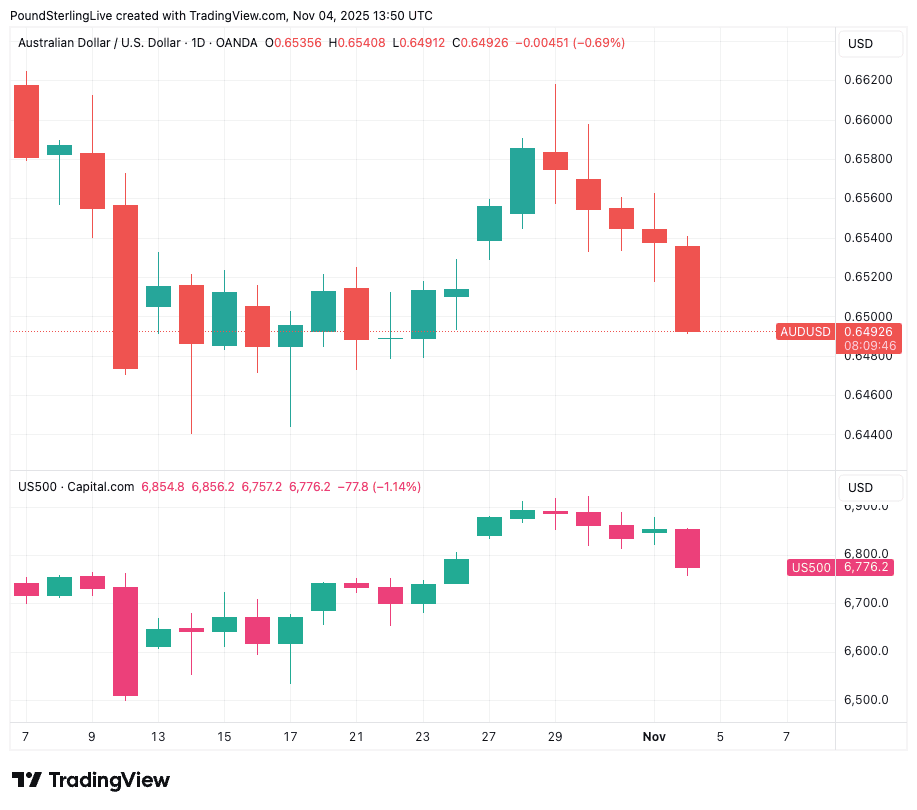
Image © Adobe Images
The Australian dollar is softer on global market weakness and Reserve Bank of Australia communications.
The Reserve Bank of Australia (RBA) left interest rates on hold on Tuesday over concerns domestic inflation has proven surprisingly resilient.
However, the Australian dollar weakened in the wake of the RBA decision, which tells us markets thought the RBA might not be as concerned about inflation as appears on first glance.
"The tone was less hawkish than we (and markets) expected, weighing on AUD/USD," says Samara Hammoud. strategist at Commonwealth Bank of Australia.
'Hawkish' typically describes a central bank that signals an inclination to raise interest rates. In the RBA’s case, the term can also apply when it opts to hold rates during a cutting cycle.
The RBA's communications would seem to suggest the door is open to cut rates again, hence the "less hawkish" tone.
How so? Max Lin at CIBC explains:
"The statement was mostly hawkish, but the market (which expected a hawkish stance) was mildly disappointed by wording which noted that 'some of the increase in underlying inflation in Q3 was due to temporary factors.'"
"AUD/USD fell by 0.25% to 0.6520 in reaction to that phrasing," he adds.
The GBP/AUD rose to 2.01736 before paring the advance in the wake of a speech given by UK Chancellor Rachel Reeves. The EUR/AUD rose half a per cent to 1.7726.
"The discussion of temporary inflation factors and the emphasis on remaining cautious softened the overall message," explains CBA's Hammoud.
All that said, we think there's a risk of overinterpreting some relatively minor statements by the RBA and don't see the RBA's November meeting being a game-changing event.
After all, the RBA made it clear that "the recent data on inflation suggest that some inflationary pressure may remain in the economy."
Australian CPI inflation climbed to 1.3% q/q in 3Q25, rising from the 0.7% q/q reading in 2Q25, and coming in stronger than consensus estimate of 1.1%. From a year ago, CPI rose 3.2% y/y, topping the 2.1% rise in 2Q25 and coming in above the 3.0% forecast.
There's a good chance the post-RBA reaction has been muddied by a more relevant 'risk off' tone in global markets, which traditionally tends to weigh on the Aussie.
"A broad risk-off sentiment at the start of the day also supported the greenback, as market participants express growing concerns over elevated stock valuations. S&P futures are down 1.0%, while Nasdaq futures have declined 1.4%," says Luis Hurtado, a strategist at CIBC Capital Markets.
"The aussie falls victim to the broader risk-off sentiment," says Achilleas Georgolopoulos, Senior Market Analyst at Trading Point.
He says market nerves are likely linked to the realisation that the Federal Reserve might not cut rates in December.
The market currently prices a 67% chance of another 25bps in mid-December, down from the 95% before last week’s meeting.
"All in all, we might be reaching a stage where the absence of official data means no Fed rate cut in December," says Georgolopoulos.

